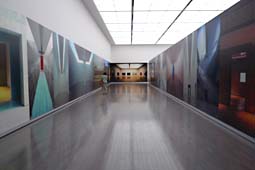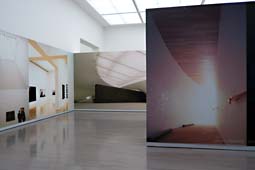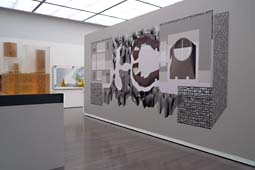 |
|
 |
| Large photographs of a mix of museum interiors made it almost seem that a person could step into each space. |
|
Surely I am not the only one who would love to see Arata Isozaki pen an autobiography -- even an abbreviated, juicy memoir. There they would be, the avant-garde of Japan's postwar era: Metabolists proposing towering structures in the air and on the sea, Gutai and Neo-Dada artists digging holes and sweeping streets, police raiding a Shinjuku party where naked Butoh dancers challenged the norms of public decency -- and Isozaki, Zelig-like, in the midst of it all. Isozaki worked with early IT artists to make Mickey-Mouse-like robots for the 1970 Osaka Expo; in the 1980s, he brought an international coterie of exciting architects to Japan's provincial corners, and designed the video-saturated space of the Palladium Club, New York's hottest nightspot. While he seemed to settle down in the 1990s, concentrating on his architectural practice, Isozaki quite literally carpeted the earth with his creative work.
Now the architect is celebrating his 77th birthday with a set of reflective exhibitions and events he calls "7 Invitations." (The Japanese title is easier to understand, translatable as "My 7 Selections.") As usual Isozaki cheats, with the straightforward "7" spliced and multiplied in funhouse mirrors. The exhibition that ran through June 22 at the Gunma Museum of Modern Art (one of Isozaki's iconic masterpieces) was entitled "Seven Art Galleries," but there were almost double that -- and an additional seven tea spaces, including one designed for John Lennon and Yoko Ono that Isozaki insists mysteriously disappeared after arriving in England. The show also offered an enigmatic art piece, calligraphy caged in an expanded metal structure resembling Isozaki's Nara Centennial Hall.
The architect has designed far more art spaces than the double sevens indicated by the exhibition. The starting seven, presented in greater depth, represent a select few he has recent or renewed relationships with:
- The Art Plaza at the Oita Prefectural Library (originally designed and built in the mid-1960s and extensively renovated in the 1990s),
- The Gunma Museum in which this show was housed (almost continually remodeled by Isozaki since its construction in the 1970s),
- The Museum of Contemporary Art in Los Angeles (completed in 1986; an audacious but unbuilt recent addition resembling his 1962 "City in the Air" is included in the second set of exhibited environments),
- The 1988 Hara Museum Arc (where a shoin-inspired addition will open this July 27 with another of Isozaki's "7 Invitations," called "Seven Curations"),
- The recently renovated 1994 Nagi Museum of Contemporary Art (housing three site-specific works, including a piece by Isozaki's wife, sculptor Aiko Miyawaki),
- The soon-to-open Central Academy of Fine Arts Museum of Contemporary Art in Beijing, and
- The Shanghai Zendai Himalayas Art Center, expected to be complete in 2009.
In addition, the show offered a second, loosely organized and abridged exhibition of other projects, some unbuilt, many initially awarded through competitions, contributing to their renown.
Considering Isozaki's history of provocative postmodern exhibition designs, the Gunma show was surprisingly muted. There were none of the flashy effects often found in his earlier work. Nothing moved, triggered by breaking infrared beams. No eerie sound design was evident. The show centered around a straightforward set of sketches, construction drawings, large panels of photographs, and elegantly detailed wooden models. These were remarkably consistent across the decades, thus highlighting differences in Isozaki's interspersed artworks, and, in the simple setting, drawing greater attention to the way each project conceptually reflected the major media of its era: the early axonometrics and one-point perspectives of the Oita Art Center underscoring its geometric organization in contrast to the voluptuous, fleshy base of the Shanghai Zendai Himalayas Art Center, perhaps only possible in our age of computer-generated nurbs and blobs.
Izozaki's other "Invitations" occur throughout the year and across the globe. Those in Japan can see his show "Seven Villas" at the Oita Art Plaza through January 2009. As at Gunma, Isozaki is not content simply to claim his place in history; the show includes his earlier "Nine Houses" (again, he sets the numeric structure only to ignore it!) as well as some recent, as-yet-unpublished residences proposed for California's Mohave Desert, China and Qatar. In these exhibitions Isozaki seems to argue that he is not interested in simply looking back or reveling in his rich past; the present, it would appear, is still keeping him far too busy.
Elsewhere this year, the July opening of a new plaza by Isozaki at Bilbao's Guggenheim will be celebrated by a show of "Seven Odd Designs." In November, "Seven Built" and "Seven Projects in the Middle East" can be seen in Nanjing, China. The celebration characteristically ends the year on an oddly ambiguous note with the show "Seven Unbuilt Projects" at Isozaki's atelier in Italy.
 |
|
 |
| The Shanghai Zendai Himalayas Art Center, expected to be complete in 2009, is the most recent museum included in the show. The building clearly owes something to the computer-based media used in generating its design. |
|
The overall reliance in the show on an understated use of drawings and models highlighted how Isozaki employed artistic media, as if deliberately reflecting each era. The dark panels on the right are elegant lead relief panels done of the Hara Museum in the late 1980s -- a time when Japan's economic exuberance was often expressed in expensive and exotic media.
All photos by Dana Buntrock |
|